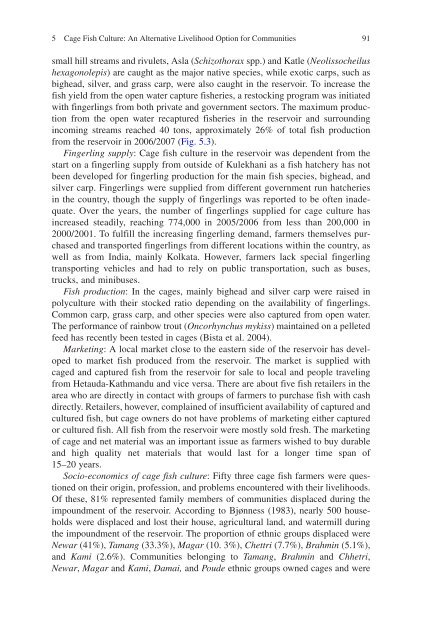Success Stories In Asian Aquaculture - Library - Network of ...
Success Stories In Asian Aquaculture - Library - Network of ...
Success Stories In Asian Aquaculture - Library - Network of ...
- No tags were found...
Create successful ePaper yourself
Turn your PDF publications into a flip-book with our unique Google optimized e-Paper software.
5 Cage Fish Culture: An Alternative Livelihood Option for Communities91small hill streams and rivulets, Asla ( Schizothorax spp.) and Katle ( Neolissocheilushexagonolepis ) are caught as the major native species, while exotic carps, such asbighead, silver, and grass carp, were also caught in the reservoir. To increase thefish yield from the open water capture fisheries, a restocking program was initiatedwith fingerlings from both private and government sectors. The maximum productionfrom the open water recaptured fisheries in the reservoir and surroundingincoming streams reached 40 tons, approximately 26% <strong>of</strong> total fish productionfrom the reservoir in 2006/2007 (Fig. 5.3 ).Fingerling supply : Cage fish culture in the reservoir was dependent from thestart on a fingerling supply from outside <strong>of</strong> Kulekhani as a fish hatchery has notbeen developed for fingerling production for the main fish species, bighead, andsilver carp. Fingerlings were supplied from different government run hatcheriesin the country, though the supply <strong>of</strong> fingerlings was reported to be <strong>of</strong>ten inadequate.Over the years, the number <strong>of</strong> fingerlings supplied for cage culture hasincreased steadily, reaching 774,000 in 2005/2006 from less than 200,000 in2000/2001. To fulfill the increasing fingerling demand, farmers themselves purchasedand transported fingerlings from different locations within the country, aswell as from <strong>In</strong>dia, mainly Kolkata. However, farmers lack special fingerlingtransporting vehicles and had to rely on public transportation, such as buses,trucks, and minibuses.Fish production : <strong>In</strong> the cages, mainly bighead and silver carp were raised inpolyculture with their stocked ratio depending on the availability <strong>of</strong> fingerlings.Common carp, grass carp, and other species were also captured from open water.The performance <strong>of</strong> rainbow trout ( Oncorhynchus mykiss ) maintained on a pelletedfeed has recently been tested in cages (Bista et al. 2004) .Marketing : A local market close to the eastern side <strong>of</strong> the reservoir has developedto market fish produced from the reservoir. The market is supplied withcaged and captured fish from the reservoir for sale to local and people travelingfrom Hetauda-Kathmandu and vice versa. There are about five fish retailers in thearea who are directly in contact with groups <strong>of</strong> farmers to purchase fish with cashdirectly. Retailers, however, complained <strong>of</strong> insufficient availability <strong>of</strong> captured andcultured fish , but cage owners do not have problems <strong>of</strong> marketing either capturedor cultured fish. All fish from the reservoir were mostly sold fresh. The marketing<strong>of</strong> cage and net material was an important issue as farmers wished to buy durableand high quality net materials that would last for a longer time span <strong>of</strong>15–20 years.Socio-economics <strong>of</strong> cage fish culture : Fifty three cage fish farmers were questionedon their origin, pr<strong>of</strong>ession, and problems encountered with their livelihoods.Of these, 81% represented family members <strong>of</strong> communities displaced during theimpoundment <strong>of</strong> the reservoir. According to Bjønness (1983) , nearly 500 householdswere displaced and lost their house, agricultural land, and watermill duringthe impoundment <strong>of</strong> the reservoir. The proportion <strong>of</strong> ethnic groups displaced wereNewar (41%), Tamang (33.3%), Magar (10. 3%), Chettri (7.7%), Brahmin (5.1%),and Kami (2.6%). Communities belonging to Tamang , Brahmin and Chhetri ,Newar , Magar and Kami , Damai, and Poude ethnic groups owned cages and were
















